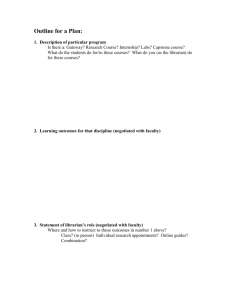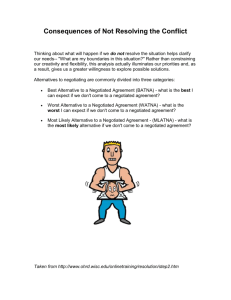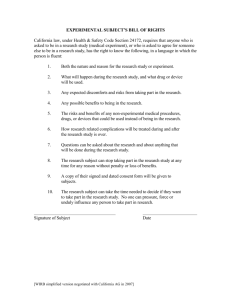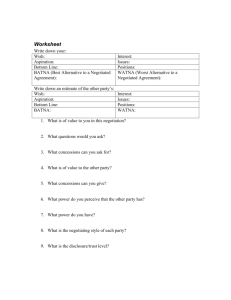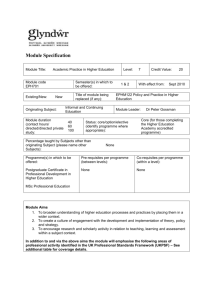ISSUE 2: DISTRIBUTION OF F&A RATES BY SPENDING CATEGORY
advertisement
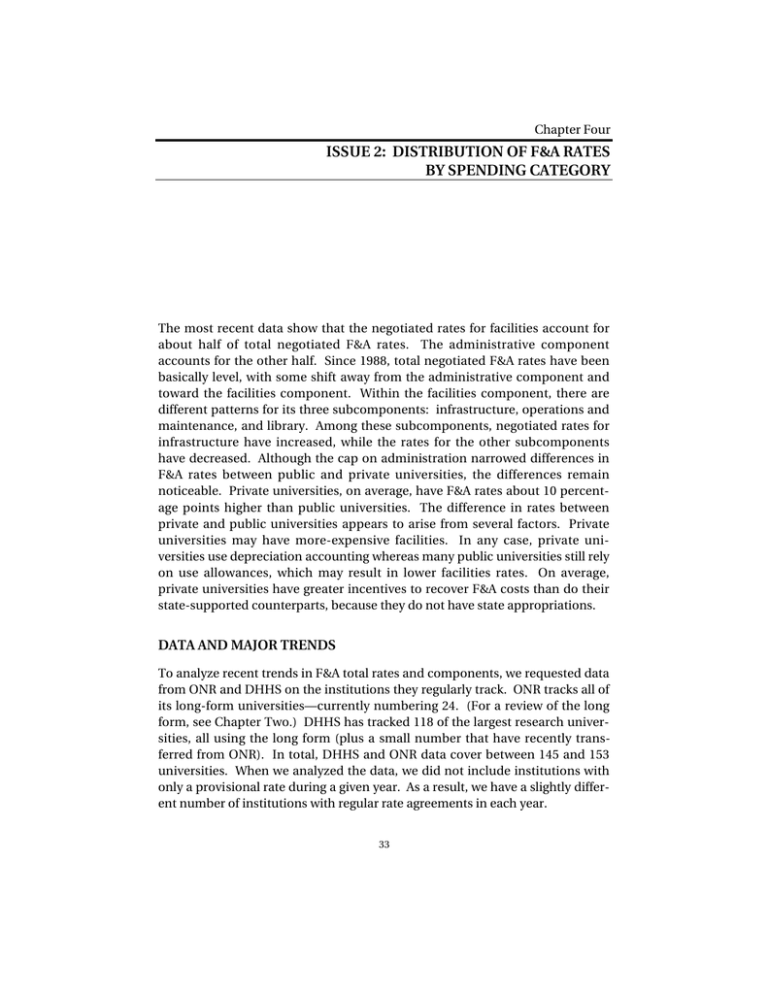
Chapter Four ISSUE 2: DISTRIBUTION OF F&A RATES BY SPENDING CATEGORY The most recent data show that the negotiated rates for facilities account for about half of total negotiated F&A rates. The administrative component accounts for the other half. Since 1988, total negotiated F&A rates have been basically level, with some shift away from the administrative component and toward the facilities component. Within the facilities component, there are different patterns for its three subcomponents: infrastructure, operations and maintenance, and library. Among these subcomponents, negotiated rates for infrastructure have increased, while the rates for the other subcomponents have decreased. Although the cap on administration narrowed differences in F&A rates between public and private universities, the differences remain noticeable. Private universities, on average, have F&A rates about 10 percentage points higher than public universities. The difference in rates between private and public universities appears to arise from several factors. Private universities may have more-expensive facilities. In any case, private universities use depreciation accounting whereas many public universities still rely on use allowances, which may result in lower facilities rates. On average, private universities have greater incentives to recover F&A costs than do their state-supported counterparts, because they do not have state appropriations. DATA AND MAJOR TRENDS To analyze recent trends in F&A total rates and components, we requested data from ONR and DHHS on the institutions they regularly track. ONR tracks all of its long-form universities—currently numbering 24. (For a review of the long form, see Chapter Two.) DHHS has tracked 118 of the largest research universities, all using the long form (plus a small number that have recently transferred from ONR). In total, DHHS and ONR data cover between 145 and 153 universities. When we analyzed the data, we did not include institutions with only a provisional rate during a given year. As a result, we have a slightly different number of institutions with regular rate agreements in each year. 33 34 Paying for Research Facilities and Administration There are two basic ways to present F&A costs and rates. In Chapters Two and Three we used one basis: the fraction of total awards or project costs for F&A costs. We shift from here on to presenting negotiated F&A rates as a percentage of MTDC. As explained in Chapter Two, negotiated rates may vary from the actual cost structure of the university because of mandatory and voluntary costsharing. At the end of this chapter, we introduce additional data on the actual recovery rates of universities. In discussing negotiated rates as a percentage of MTDC, it is useful to recall the relationship between negotiated rates and the fraction of total federal payments that goes for F&A. The average negotiated F&A rate for the universities analyzed in Chapter Two is 51 percent of MTDC. That 51 percent figure does not mean that half the expenses are for facilities and administration. The analysis in Chapter Two shows that federal outlays to those universities were divided in the proportion 25 percent for F&A reimbursements and 75 percent for direct costs. Table 4.1 and Figure 4.1 summarize the average negotiated facilities and administrative reimbursement rates as a percentage of MTDC for this group of institutions from 1988 through 1999. The average F&A rate has changed very little between 1988 and 1999. There has been some shift in the major components of the rate, though. Administrative costs reimbursed through F&A rates have declined, while facilities costs reimbursed have increased. We do not know if true administrative costs at universi- Table 4.1 Average of Total Negotiated F&A Rate and Major Components (percentage of MTDC) Fiscal Year 88 89 90 91 92 93 94 95 96 97 98 99 Number of Institutions Total Rate 146 146 146 146 149 147 147 148 148 148 153 145 50.6 50.8 51.8 51.9 52.2 50.5 50.6 50.9 50.8 50.9 51.0 50.8 Administrative Facilities Carry Forward 27.3 27.6 27.7 27.5 27.4 24.9 25.1 25.1 25.1 25.3 25.2 25.2 23.2 23.6 24.1 24.3 24.8 25.6 25.7 25.8 25.6 25.9 26.0 25.4 0.1 –0.3 0.0 0.1 0.1 0.1 –0.1 0.1 0.1 0.1 –0.1 0.0 SOURCE: Database compiled from ONR and DHHS, 1999. Lowest Highest Total Rate Total Rate 25.0 25.0 33.5 37.0 37.0 33.5 33.0 36.3 36.1 25.0 37.1 34.9 87.5 82.3 78.0 88.0 88.0 83.0 83.0 79.9 79.9 79.9 79.9 74.5 Distribution of F&A Rates by Spending Category 35 RANDMR1135-4.1 90 80 Highest F&A rate 70 60 Rate Average F&A rate 50 40 30 Lowest F&A rate 20 10 0 1988 1989 1990 1991 1992 1993 1994 1995 1996 1997 1998 1999 Year SOURCE: Database compiled from ONR and DHHS, 1999. Figure 4.1—Trends in Average, Highest, and Lowest Negotiated F&A Rates, 1988–1999 (percentage of MTDC) ties have decreased, because in 1993 universities became subject to a 26 percent cap on reimbursement of indirect costs. The administrative cap is discussed further in Chapter Five. Because of the 26 percent administrative cap, it is not useful to distinguish subcomponents of the administrative portion of the rates, such as general administration, sponsored projects administration, departmental administration, and student services. Because many universities present true administrative costs that exceed the 26 percent cap, it is not clear exactly which costs the federal government is actually reimbursing. If universities did not reduce their administrative costs following imposition of the cap, they are using other sources of funds to pay for the costs that exceed the cap. In contrast to the administrative components, facilities components offer some information about trends. Table 4.2 summarizes the average values for these components. The column labeled “Infrastructure” includes negotiated rates for buildings and equipment at a university. The total negotiated facility rate increased modestly from 1988 to 1999. The larger total arises from increases in the infrastructure portion, while operations and maintenance budgets have decreased. The trends in these facilities components are discussed further in Chapter Five. Figures 4.2 and 4.3 graph the overall trends in negotiated F&A rates during the same period. The strong effect of the administrative cap in 1993 is evident in Figure 4.2. Since then, the administrative component has been flat. 36 Paying for Research Facilities and Administration Table 4.2 Average of Facilities Components of Negotiated F&A Rates (percentage of MTDC) Fiscal Year 88 89 90 91 92 93 94 95 96 97 98 99 Facilities Total Infrastructure Operations and Maintenance Library 23.2 23.6 24.1 24.3 24.8 25.6 25.7 25.8 25.6 25.9 26.0 25.4 5.9 6.1 6.5 7.0 7.3 7.9 8.2 8.3 8.4 8.6 8.8 9.0 15.2 15.2 15.4 15.1 15.5 15.6 15.5 15.6 15.4 14.8 15.2 14.7 2.1 2.2 2.2 2.2 2.1 2.0 1.9 1.9 1.9 1.8 1.9 1.8 NOTE: Infrastructure includes depreciation, use allowances, interest, and other costs. SOURCE: Database compiled from ONR and DHHS, 1999. Figure 4.3 shows that negotiated rates for facilities increased from 1988 to 1993 and have been basically unchanged since 1993 with some slight fluctuations. VARIATIONS IN NEGOTIATED F&A RATES Within these averages, there is considerable variation from one institution to another. Several studies have analyzed the reasons for these variations. Different regions of the country have different climates with corresponding requirements for heating and cooling. Universities with more modern facilities will generally have higher expenses for infrastructure (including depreciation and interest), although expenses for operations and maintenance may be lower. The size of the institution’s research base may have an impact on F&A rates because more activity within a given space enables the university to operate more efficiently. Even more important is a good match between the size of the research base and facilities to conduct the research at maximum efficiency. Facilities that are underutilized—or too crowded—are not good values for the university or the government. A good match makes it more likely that the government is reimbursing to the university at a level that closely matches its costs to operate facilities. 1 ______________ 1 These and other factors are discussed in NSF, 1991; COGR, 1988; and COGR, 1998b. Distribution of F&A Rates by Spending Category RANDMR1135-4.2 30 25 Rate 20 15 10 5 0 1988 1989 1990 1991 1992 1993 1994 1995 1996 1997 1998 1999 Year SOURCE: Database compiled from ONR and DHHS, 1999. Figure 4.2—Trends in Administrative Component of Negotiated F&A Rates, 1988–1999 (percentage of MTDC) RANDMR1135-4.3 30 25 Rate 20 15 10 5 0 1988 1989 1990 1991 1992 1993 1994 1995 1996 1997 1998 1999 Year SOURCE: Database compiled from ONR and DHHS, 1999. Figure 4.3—Trends in Facilities Component of Negotiated F&A Rates, 1988–1999 (percentage of MTDC) 37 38 Paying for Research Facilities and Administration Public universities consistently have lower average negotiated F&A rates than private universities do. Public universities in the past may have had less incentive to negotiate strongly for F&A reimbursement because much of their F&A costs were paid by state appropriations and some state governments did not give universities strong incentives to seek reimbursement of those costs from the federal government. In addition, there may be differences in the type of research performed at public universities or in the average age of their research facilities. Age and sophistication of research facilities both influence the cost structure in important ways. More sophisticated facilities involve higher construction costs as well as typically higher costs for operations, such as ventilation. Very old facilities are no longer depreciated or charged use allowances. In addition, universities may include some interest charges for financing facilities constructed since 1982, as discussed in Chapter Five. For these reasons, universities with newer facilities have more charges for facilities. Even newer facilities in public universities may use allowances rather than depreciation because their financial systems do not support accounting for depreciation. Private universities have been required to adopt depreciation accounting since 1988. Public universities will not have this requirement until 2001, as discussed in Chapter Five. Private universities’ higher negotiated rates are likely explained by a combination of these factors: greater incentive to recover F&A costs, more new construction, and depreciation instead of use allowances. The determination of the base over which to distribute F&A costs could be the most important factor in understanding rates. At some universities, the medical school is budgeted separately and is assigned an F&A rate separate from the rest of the university. Because medical schools engage in primarily biomedical research, which on average appears to use more specialized facilities and administration than other fields of science, they have higher average negotiated F&A rates compared with universities that lack medical schools in their base. Possibly, medical schools are simply better at documenting their costs, but the many special regulations applying to this field seem consistent with a higher cost structure in biomedicine. These regulations are described in Chapter Six and cover environmental health, animal care, and human subjects protection. Figure 4.4 shows that public universities (represented by the two lower lines) have lower F&A reimbursement rates than private institutions do. This difference was about 13 percentage points in the late 1980s. The administrative cap, which took effect with the 1993 rates, affected private universities more than public, so this gap narrowed as private university administrative reimbursement rates declined. Recently, the gap between public and private rates has been about 10 percentage points. The thinner lines in each section indicate the separate medical schools (private and public). Separate medical schools include those separately organized as Distribution of F&A Rates by Spending Category 39 well as those in institutions that negotiate distinct F&A rates for their medical schools as opposed to their other campus units. Although the data are ambiguous before 1993, since then medical schools in each group have shown somewhat higher average F&A reimbursement rates than all other institutions have. For this purpose, all other institutions include those that either do not have medical schools or do not negotiate separate F&A rates for medical schools. Because all other institutions include a wide variety of institutions, we sought a closer comparison to examine possible differences in F&A reimbursement rates at medical colleges from other schools. Table 4.3 summarizes the results of this analysis. As shown in the table, the data had 27 or 28 medical colleges with rates in each year. For each medical college, we selected a specific comparison institution to build a comparison set. For institutions that had separate F&A rates for their medical schools and for the rest of campus, we used the rest of campus as the comparison. For stand-alone medical colleges (or where the main campus did not have a rate agreement), we selected a comparison institution within the same state and same type of control (public or private).2 RANDMR1135-4.4 70 60 Rate 50 40 30 Private medical only Private all other Public medical only Public all other 20 10 0 1988 1989 1990 1991 1992 1993 1994 1995 1996 1997 1998 1999 Year SOURCE: Database compiled from ONR and DHHS, 1999. Comparison institutions selected by RAND. Figure 4.4—Trends in Public and Private (Medical Only and All Other) Negotiated F&A Rates, 1988–1999 (percentage of MTDC) ______________ 2 For public university systems with separate medical colleges, the comparison institution would thus be a nonmedical member of the same system. In five cases where more than one comparison institution was eligible, we chose at random from the eligible choices. In two cases, no available comparison institutions were in the same state and type of control; for those, we selected an institution at random from a neighboring state with the same type of control. 40 Paying for Research Facilities and Administration The negotiated rates for administration in medical colleges and the comparison institutions are nearly identical year by year. But the negotiated rates for facilities diverge starting in the early 1990s. By the late 1990s, this difference has grown to about three percentage points.3 Although many of the comparison institutions have no significant medical activity, some institutions with a single rate for the entire campus may include medical schools. Thus, these estimates of differences for medical colleges are likely to be slightly understated. ESTIMATING ACTUAL RECOVERY RATES Chapter Two showed that universities do not recover all of the negotiated F&A rate on every project. Schools differ in their recovery experience, depending on what their negotiated rate is. To illustrate this principle, consider that most USDA project grants are limited, by statute, to 14 percent of total costs for facilities and administration.4 Theoretically, if a school’s negotiated rate were low enough, it would see no reduction at all in its F&A reimbursement from these caps because its negotiated rate would yield reimbursement consistent with the Table 4.3 Comparison of Negotiated F&A Rates at Medical Colleges and Comparison Institutions (percentage of MTDC) Medical Colleges Fiscal Year 88 89 90 91 92 93 94 95 96 97 98 99 Comparison Institutions Facilities Administrative Total Number Facilities Administrative Total Number 24.7 24.7 25.4 25.6 26.4 26.9 27.6 27.8 27.7 27.8 27.7 27.3 26.7 27.3 27.5 27.4 27.1 24.7 24.9 24.9 25.0 25.0 24.8 24.8 50.5 51.0 51.8 52.8 53.2 51.5 52.7 53.0 53.1 53.3 52.4 52.1 27 27 27 27 27 27 27 27 28 28 28 27 23.8 24.1 24.6 24.7 24.0 25.0 24.9 25.2 24.3 24.9 24.8 24.2 25.9 26.6 26.6 26.7 26.5 24.9 25.2 25.1 25.2 25.2 25.2 25.2 50.0 50.7 51.2 51.6 50.7 49.6 49.9 50.2 49.8 50.0 49.7 50.3 27 27 27 27 27 27 27 27 28 28 27 27 SOURCE: Database compiled from ONR and DHHS, 1999. Comparison institutions selected by RAND. ______________ 3 Using a statistical t-test, we find that the difference in 1988 is insignificant. By 1999 the difference in facility rates is significant at the 0.10 level. 4 Because the 14 percent limitation is calculated on total project costs, it can be roughly translated into an F&A rate of 20 to 30 percent of MTDC. Distribution of F&A Rates by Spending Category 41 cap. For a school with a high negotiated rate, the cap greatly reduces F&A reimbursements on these projects. As a result of caps like this in several agencies, schools with high negotiated rates tend to recover less of their negotiated rates compared with schools with low negotiated rates. To show the actual recovery by universities compared with their negotiated rates, we need information on universities’ negotiated rates, their federal MTDC base, and their actual F&A recovery. Because expenditure data generally are maintained by each program within each agency (and some programs may not currently track F&A reimbursement separately), we do not have comprehensive government data to address this question. These quantities are surveyed annually in the voluntary survey conducted by the COGR discussed in Chapter Two. About 130 COGR member institutions respond to the survey each year, including 80 percent of the institutions tracked by DHHS and ONR included in the above analyses. Over the four-year period between 1994 and 1997, we obtained 351 complete records from this survey, an average of 88 institutions each year. Figure 4.5 summarizes these data, showing the relationship between negotiated F&A rate and actual recovery rate (without regard to year).5 The figure shows that no group of institutions on average recovers its full negotiated rate. For institutions with the lowest negotiated rates, the recovery rate is closer to the negotiated rate than it is for institutions with higher negotiated rates. The small sample size in general—and in particular in the last few bars on the right—means that we cannot claim validity for small differences reported among groups in the figure. The figure should be taken in a general sense to indicate that cost-sharing of facilities and administration is widespread and proportionally higher in universities with higher negotiated rates. Institutions with higher negotiated rates, on average, also share a larger fraction of F&A costs. Although they may recover their full negotiated rate on some grants and contracts, in many instances they do not. Institutions with negotiated rates between 40 and 60 percent (a range that accounts for three-quarters of these institutions) report receiving, on average, about 77 percent of their negotiated F&A reimbursement. These results indicate that any proposed changes in negotiated F&A rates may have unanticipated effects, because the relationship between negotiated rates and actual reimbursement is mediated by several factors, including agency limitations on F&A reimbursement and cost-sharing. It is possible that reduc______________ 5 Because there is very wide variation in the actual recovery amounts from year to year for a given institution, as well as across institutions, we used medians to indicate the basic relationships in the data. 42 Paying for Research Facilities and Administration ing negotiated F&A rates could also reduce university cost-sharing resulting in no change in federal outlays for F&A reimbursements. To summarize, overall trends in negotiated F&A rates have been basically level. Rates for administration have declined somewhat, while rates for facilities have increased about equally. In terms of negotiated rates, the administrative cap narrowed differences between public and private universities, but the differences remain noticeable. We do not know the precise explanation for these differences. The explanation is likely to involve some combination of moreexpensive facilities at private universities, depreciation accounting instead of use allowances, and greater incentives, on average, for private universities to recover F&A costs than for their state-supported counterparts. Examining data on actual recovery of costs by universities shows that negotiated rates do not tell the full story. There are statutory limitations on F&A recovery for all institutions, but these limitations have a greater proportional RANDMR1135-4.5 80 2 Negotiated F&A rate Actual F&A recovery 70 60 7 9 11 18 Rates 50 21 17 40 30 20 10 0 40–45 45–50 50–55 55–60 60–65 65–70 70–75 Negotiated rate range SOURCE: Database compiled from COGR, 1994–1997. NOTE: Observations are grouped by negotiated F&A rate without regard to the year. The groups are formed with negotiated rates in the ranges 40–45, 45–50, 50–55, 55– 60, 60–65, 65–70, and 70–75 percent. For each group the figure plots the median negotiated rate and the median actual recovery rate. The number of institutions in each group reported on the x-axis is computed by taking the number of observations in each range without regard to the year and dividing by four (the number of years of data) and rounded to the nearest whole number for display. Figure 4.5—Comparison of Negotiated F&A Rates with Actual Recovery, 1994–1997 (percentage of MTDC) Distribution of F&A Rates by Spending Category 43 effect when negotiated F&A rates are higher. For this reason and perhaps for other reasons, we find that universities with higher negotiated F&A rates also provide more cost-sharing for F&A costs. As a result, it is difficult to make judgments about federal outlays for F&A costs on the basis of data on rates alone or to predict the effect of changes in F&A reimbursement policies.
